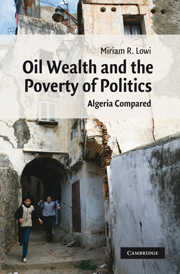Book contents
- Frontmatter
- Contents
- List of tables
- List of figures
- Preface
- Map of Algeria
- Part I Introduction
- Part II Algeria and its discontents
- 3 From conquest to independence
- 4 The elaboration of a system
- 5 From boom to bust, and … verging on breakdown
- 6 The persistence of violence and the process of re-equilibration
- Part III Comparisons and conclusions
- 8 Conclusions: oil wealth and the poverty of politics
- Bibliography
- Index
- CAMBRIDGE MIDDLE EAST STUDIES 32
5 - From boom to bust, and … verging on breakdown
Published online by Cambridge University Press: 29 March 2010
- Frontmatter
- Contents
- List of tables
- List of figures
- Preface
- Map of Algeria
- Part I Introduction
- Part II Algeria and its discontents
- 3 From conquest to independence
- 4 The elaboration of a system
- 5 From boom to bust, and … verging on breakdown
- 6 The persistence of violence and the process of re-equilibration
- Part III Comparisons and conclusions
- 8 Conclusions: oil wealth and the poverty of politics
- Bibliography
- Index
- CAMBRIDGE MIDDLE EAST STUDIES 32
Summary
At the FLN congress of January 1979, Chadli Benjedid was named sole candidate for the presidency. He had been head of wilaya II (the second military district) during the War of Independence and was a fairly colorless member of Boumedienne's Council of the Revolution. He was put into power by the military, the most powerful institution in the country. In choosing a former FLN colonel, the preponderance of the military in political life was maintained, while the symbolic role of the party was acknowledged.
Despite some differences in window-dressing, the first three regimes of the independent state were bureaucratic–authoritarian and patrimonial in structure. They shared deep ideological affinities that conformed to the foundational myths inherited from the nationalist movement: that of popular sovereignty and national unity. The broad strategies of governance were fundamentally the same as well. The regimes remained wedded to the single party, a prominent state sector, and the nationalization of the economy (Carlier 1995: 335–6). They did so to confront – but at the same time to dismiss – the segmentarity, regional disparities, “ruralism,” and underdevelopment that so characterized Algerian society and threatened incumbents. Increasingly, however, a military caste would dominate: it would stand at the helm of what was the FLN–ALN system, and utilize civilian presidents as its “front men” (Roberts 2007: 8).
Notwithstanding the continuity that so characterized what Algerians came to call le système, the latter was constantly fraught with tensions.
- Type
- Chapter
- Information
- Oil Wealth and the Poverty of PoliticsAlgeria Compared, pp. 102 - 125Publisher: Cambridge University PressPrint publication year: 2009

